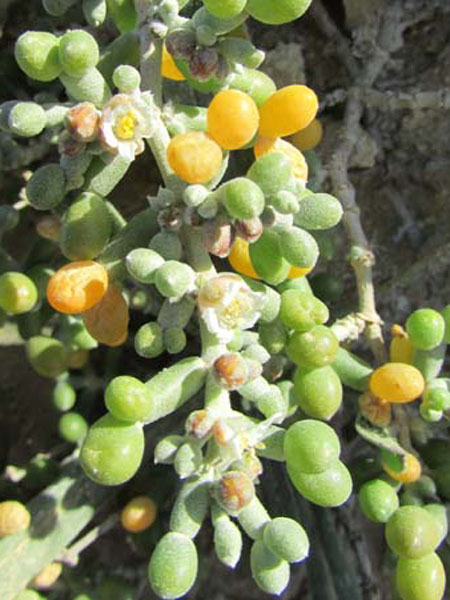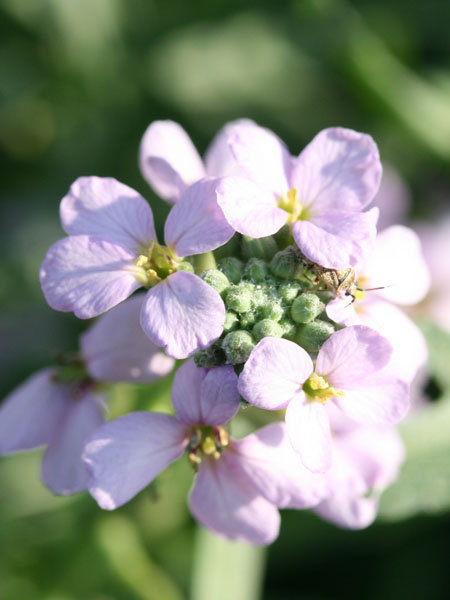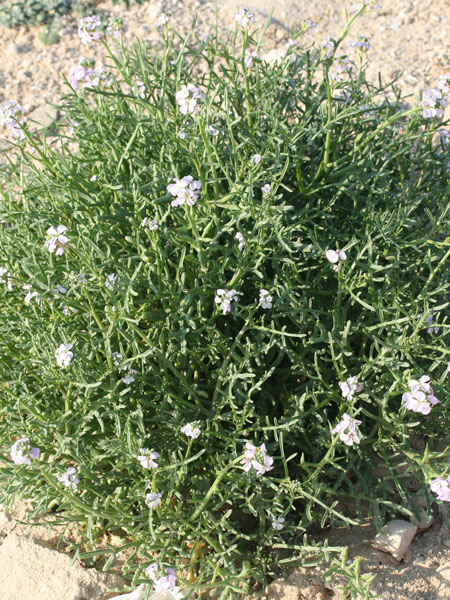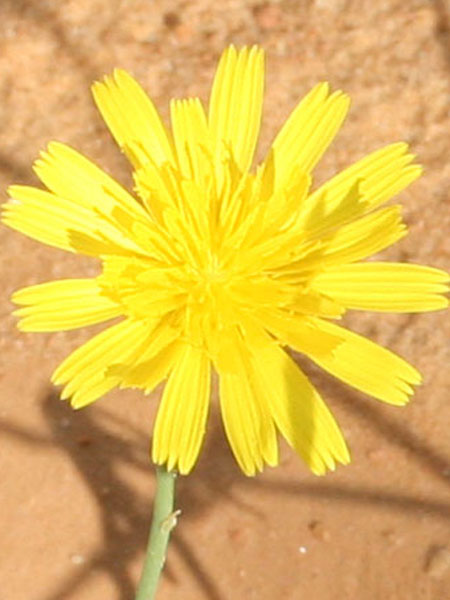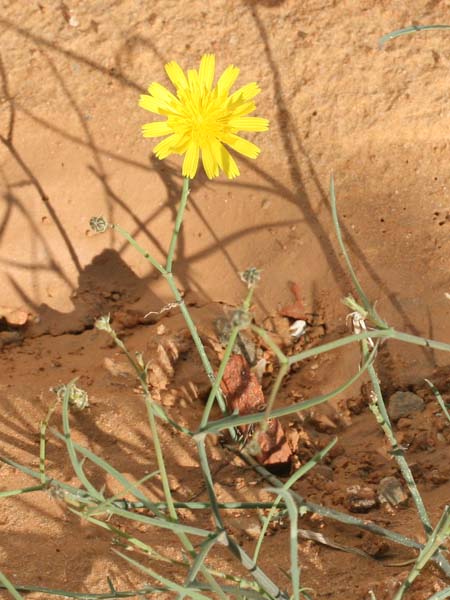Fagonia cretica
Kingdom : Plantae / النّباتات
Division : Spermaphyta / البذريات
Clade : Magnoliophyta or Angiospermae / مستورات البذور
Class : Eudicotyledoneae / ذات الفلقتين
Order : Zygophyllales / رتبة القِدِّيسيات أو الرُّطرَيطيات
Family : Zygophyllaceae / فصيلة القدّيسيات
Genus : Fagonia
species : cretica
Chromosomes: 2n=18
Protologue
L., Sp. Pl., ed. 1, 386 (1753)
Common names
Tunisia Arabic English French Tamazight
ام ذينة
شقاع
شكاعة كريتيّة
Virgin's Mantle
Khorasan thorn
Fagonie de crête
Chouriga
Toxic
no
Edible
yes
Latex
no
Botanic description
Genus description
"Non-fleshy leaves, purple flowers: Sepals 5, deciduous. Petals 5, hoofed, purplish. stamens 10. 1 style in awl. Pyramidal ovary formed by 5 uniovulate carpels that separate at maturity. Rowing plants with opposite leaves 1-3 leaflets, i stipules thorny. Isolated axillary flowers.
Species description
"Plant glabrous except the peduncles. It has a sweet taste, bitter, strong sour according to the different stages of growth and according to the parts of the plant.
Stems stipular thorny at 4 angles. Leaves small opposite, petiole at most as long as lanceolate-acute, trifoliolate, stipules leaflets in awl, shorter than the petiole, thorny. Flowers solitary axillary, pedunculated. Purple petals, 2-3 times longer than the calyx, long ungulate. Fruits angular septicidal capsule with 5 lobes ciliated on the angles. Seeds small, ovoid, smooth, red.
Botanic References
Pottier-Alapetite G. (1981). Flore de la Tunisie Angiospermes –Dicotylédones (Apétales- Dialypétale , Première partie). Imprimerie Officielle de la République Tunisienne (Eds),451 p. Edouard LE FLOC’H, Loutfy BOULOS et Errol VELA. (2010). Catalogue synonymique commenté de la FLORE DE TUNISIE. République Tunisienne, Ministère de l’Environnement et du développement durable, Banque Nationale de Gènes. 500 p www.theplantlist.org
Biology
Life form perennial Type form Hemicryptophyte Photosynthesis C3
Phenology
Blooming
JanuaryFebruaryMarchAprilMayJuneJulyAugustSeptemberOctoberNovemberDecember
Fruiting
JanuaryFebruaryMarchAprilMayJuneJulyAugustSeptemberOctoberNovemberDecember
Map Localization
Ecology
Adaptation It is widespread in steppe environments and prefers bush, astragalus, jujibier and cactus shells. Salt bladder yes Invasive no
Geographical distribution
Localization Biocimatic stage Annuel pluviometry (mm) GPS Monastir (Falaise Skanès, Déc.2013) , (Sidi Ghedemssi Fév.2014,2016) Inferior semi-arid 331 35°46'42.88"N /10°47'39.99"E; 35°46'57.29"N /10°49'59.96"E Ben Arous (Radès, Mars 2016)) Lower humid - sub-humid 444 36°45'5.75"N/10°15'20.37"E
General uses
Medicinal uses
"Fagonia cretica is an excellent medicinal plant. the infusion of flowers and leaves of this plant serve to treat all types of cancers by increasing platelets (thanks to the presence of coumarins (thrombopoietin) and to fight against smallpox.
It treats all types of hepatitis (strengthens the liver, prevents and cures liver cancer). It improves cardiac activity and mental capacity. It is useful in the treatment of body pains. It strengthens the stomach and increases urination and therefore controls the kidneys, asthma and breathing difficulties as well as allergy problems. It improves blood purification (can save from cerebral hemorrhage and heart problems by decomposition of the stub). It treats white blood cells (it improves immunopotential property). It increases hemoglobin levels in red blood cells even at low doses (potential use in the treatment of anemia and thalassemia major). It normalizes the disorders of the arterial pressure. It relieves vomiting, thirst and burning sensation and increases physical strength. It helps in the recovery from the side effects of smoking and heals the pimples and problems of dermatology. It is applied in case of stiff neck and it is useful in weight control for obese people (hypolipidemia). It improves sperm count in sperm and helps regulate reproductive tract in men and women. It is perfectly master leucorrhea disorders in women. It heals perfectly from Atthra, an incurable feminine disease (appearance of blue or black spots on the skin in different parts of the body). It can be used to treat fever. Treats dropsy, typhoid. Use for toothache. It has an antimicrobial activity thanks to its flavonoid compounds. It has a potential source of phytotoxic substances and insecticidal agents. It may have a potential in the pharmaceutical industry and the cosmetic and aromatherapy industries.
NOTE : This website is not that of herbal medicine and assumes no responsibility for the negative effects of the use of plants. Seek advice from a professional before using a medicinal plant.
Systems / Organs / Effects
Digestive System Nervous System Urinary System Respiratory System Mouth / Teeth Stimulant Antiseptic Antiinflammatory Astringent Antipyreritic Anti-cancer Liver Skin Scalp
Test results
TPC DPPH ABTS+ FRAP Year mg GAE g-1 MS CI50 g ml-1 CI50 g ml-1 CE50 g ml-1 17,42± 0,77 166,68± 14,31 278,28± 2,92 832,53± 32,90 2016 Total Phenols content(TPC), Anti-radical potentialities against (DPPH, ABTS), Ferric reducing antioxidant power(FRAP)
Molecules : ADN / Proteins
Chromosomes : 18 Uniprot NCBI
Tunisian references
Chaieb M et Boukhris M (1998). Flore succincte et illustrée des zones arides et sahariennes de Tunisie. Association pour la protection de la nature et de l’environnement, Sfax. 157 p.
Other references
Anjum MI, Ahmed E, Jabbar A (2007). Antimicrobial Constituents from Fagonia cretica- J. chemical society of Pakistan Volume: 29 Issue: 6 DEC Pages: 634-639. Aswarthappa, B., Korlam, S., Reddy, B.T., Priya, M.V., Moulali, D.A., 2015 . Phytochemical and antimicrobial analyses of essential oils of Fagonia cretica L. Journal of Biomedical and Pharmaceutical Research. Volume 4, Issue 1, 61-64. Hussain A, Zia M, Mirza B (2007) Cytotoxic and antitumor potential of Fagonia cretica L. Turkish Journal of Biology 31: 19-24. Jahala OAM , Musa Izzeldin O, Eltayeb Abdalla R.(2014) Effect of Fagonia cretica linn ethanolic extract on different hematological parameters in albino rats in Sudan The Pharma Innovation Journal; 3(9): 89-93. Majid I, Najeeb U, Muhammad I,Usman AAJ (2015) In-Vitro Antibacterial Study of Fagonia Cretica Majid Iqbalet al. International Journal of Recent Research Aspects ISSN: 2349-7688, Vol. 2, Issue 4, December 2015, pp. 6-9 © 2014 IJRRA All Rights Reserved page - 6- Pervaiz I, Dildar A, Muhammad Nadeem A (2014). A comparative in vitro antioxidant potential profile of extracts from different parts of Fagonia cretica. Asian Pac J Trop Med 2014; 7(Suppl 1): S473-S480. Rawal A, Muddeshwar M, Biswas S (2004) Effect of Rubia cordifolia, Fagonia cretica linn, and Tinospora cordifolia on free radical generation and lipid peroxidation during oxygen-glucose deprivation in rat hippocampal slices. Biochemical and Biophysical. Research Communications 324: 588-596. Saeed MA (1969). Hamdard Pharmacopoeia of Eastern Medicine, Hamdard Academy, Karachi, pp.41-43. Seed MA, Khan Z and Sabir AW (1999). Effects of Fagonia cretica L. constituents on various endocrinological parameters in rabbits. Turkish J. Biol., 23(2): 187-197. Sajid B, Alia E, Rizwana K, Uzma S, Alamgeer HMI (2011).Phytochemical screening and antimicrobial activity of Fagonia cretica plant extracts against selected microbes, J. Pharm. Res.Apr, Vol. 4 Issue 4, p962. Thetwar LK, Thakur AS, Shrivastava S (2006). Antimicrobial efficacy of methanolic extracts of Fagonia cretica. - Asian J. Chem. Volume: 18 Issue: 1 JAN-MAR Pages: 743-744.




























